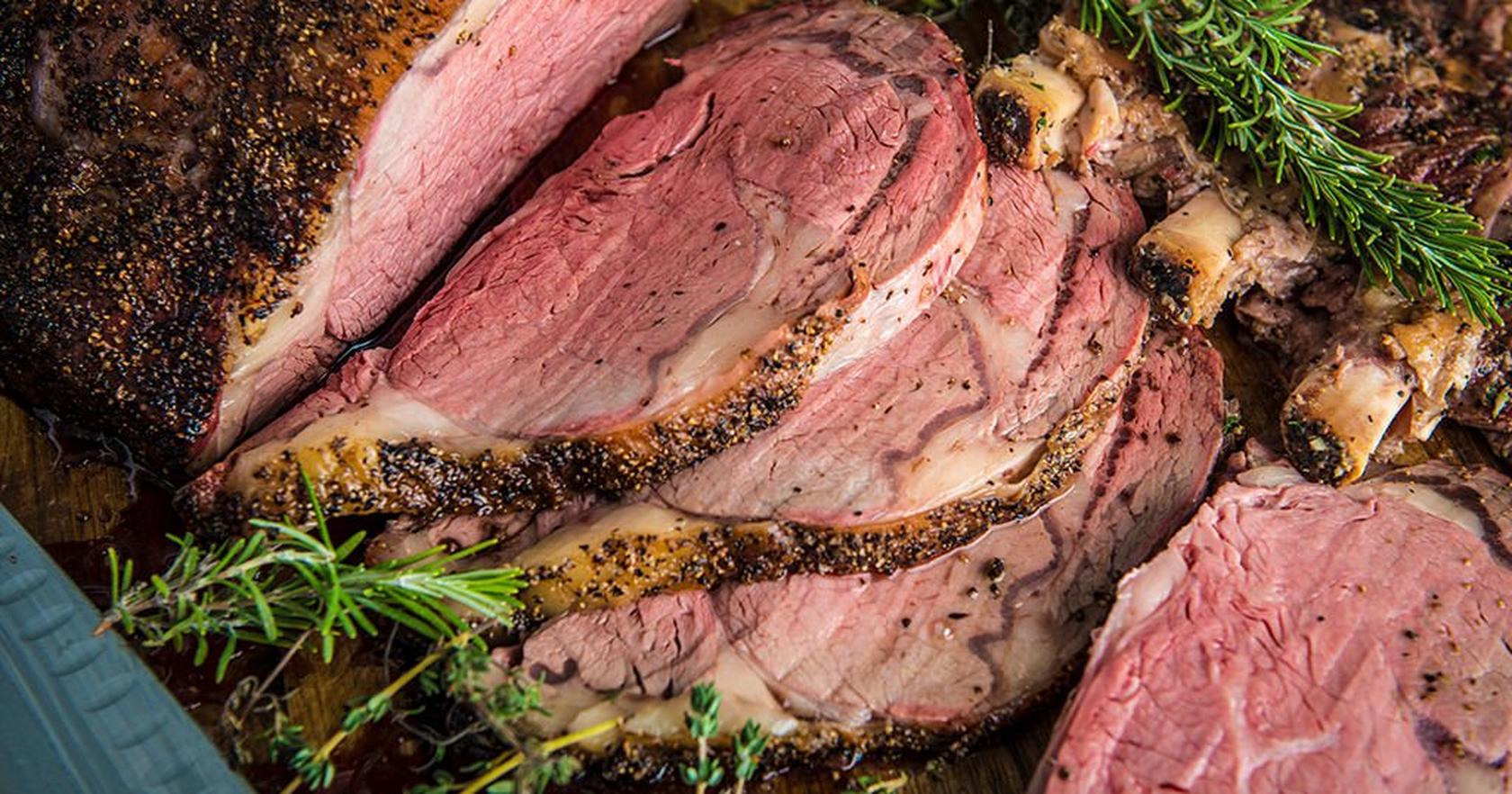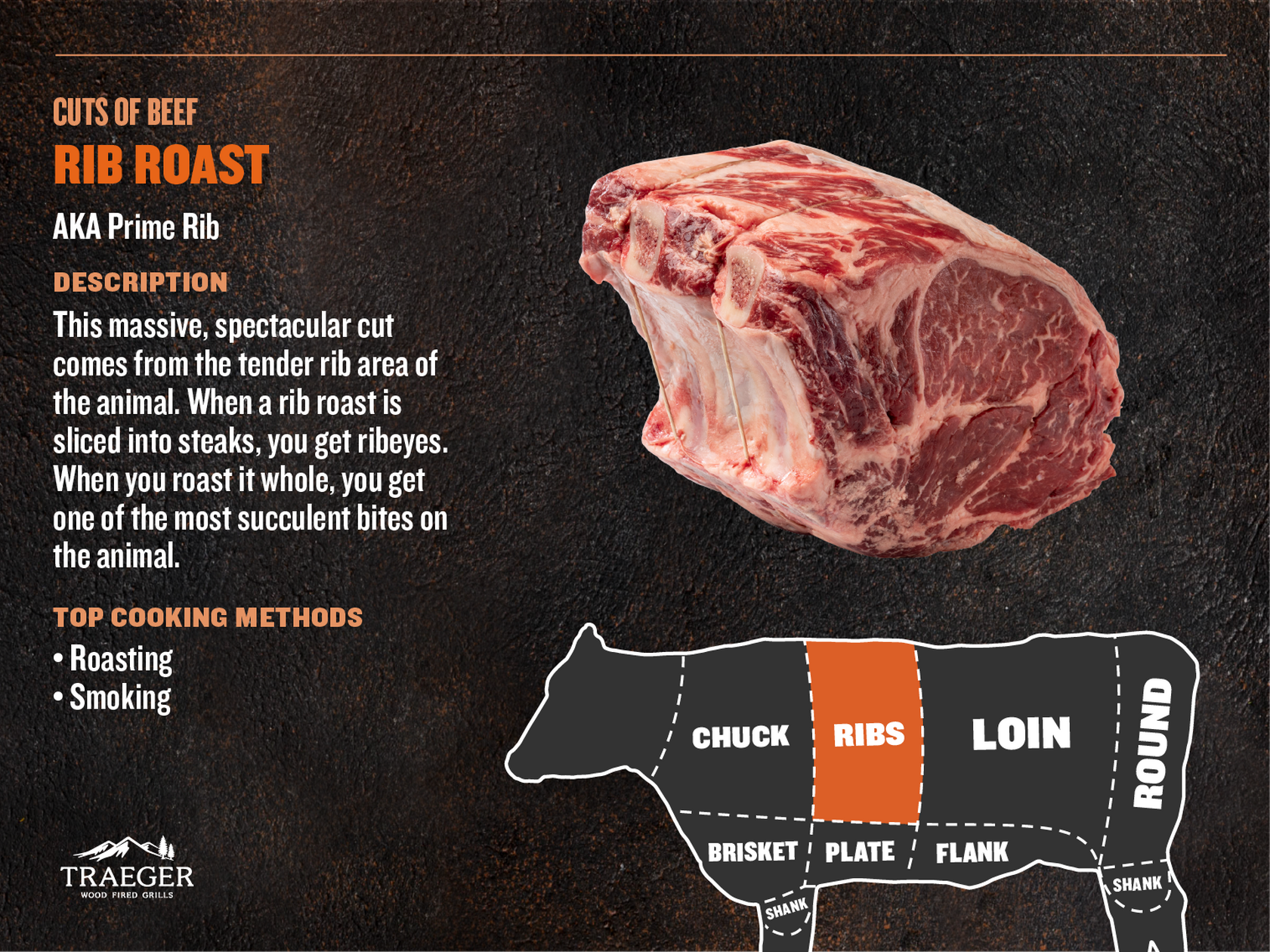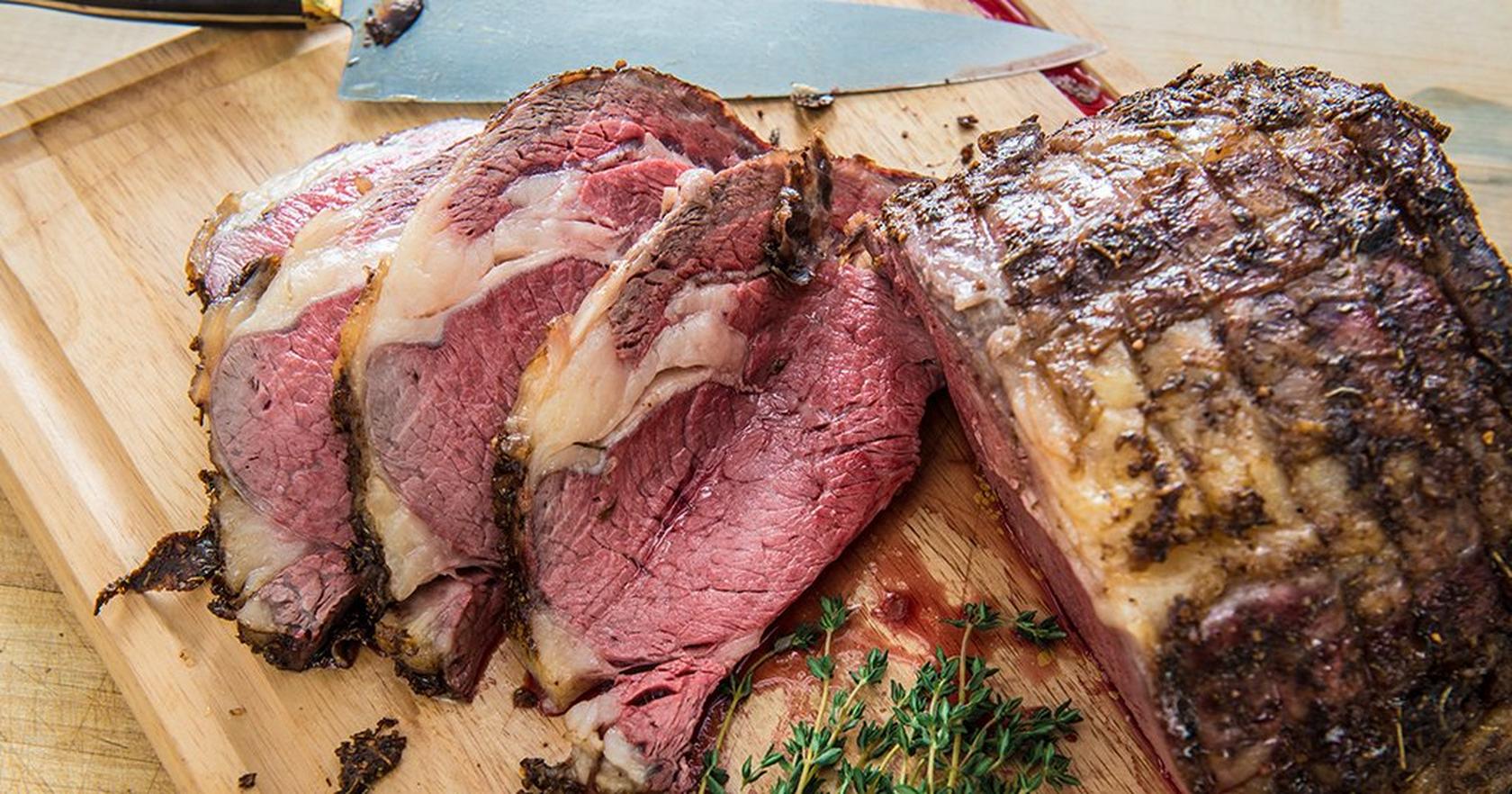
Perhaps you have been to a wedding where one of the entrée options was prime rib. And maybe you’ve hosted a celebratory dinner in which you cooked a stunning standing rib roast. What you may not know is that a beef rib roast and prime rib are actually one and the same. And just to complicate things further, the word prime has nothing to do with the USDA rating. It’s called prime rib because the cut comes from the cow’s primal rib section.
Prime rib is a large cut of beef that is then sliced for serving. If a prime rib roast is cut into individual servings before cooking, however, you have ribeye steak! Let’s go a little deeper into the confusing world of beef cut names.
Understanding the Cuts
It would be nice to live in a world where everyone called a meat cut the by the same name. But, no, that would be too easy. As our meat cuts guide shows, meat cuts can go by many different aliases, often related to regional differences.
What is a Rib Roast?
As already mentioned, a rib roast is a large piece of meat cut from just underneath the cow’s backbone, specifically ribs 6 through 12. The ribs surround a large eye of meat that is both tender and flavorful.
A full rack is gigantic, with 7 ribs (yes, the math feels funny, but if you count ribs 6 to 12 on your fingers you will get 7) and weighing up to 20 pounds. (In case you’re wondering where ribs one to five went, they are found, also somewhat confusingly, toward the front of the cow in the chuck primal and not the rib primal. There’s also a 13th rib located in the loin.)
It's the rare market that sells a whole rack—though you can order them from your butcher or online. Most of the time, the rack is cut down into more manageable roasts ranging from 2 to 5 ribs.
A rib roast can be bone-in or boneless. When it’s bone-in, it’s usually called a standing rib roast because the meat stands on the bones as it cooks**.** A boneless roast is sometimes called a rib eye roast.
Most professional cooks will recommend cooking the roast with the ribs intact to help insulate the meat and keep it moist. But a boneless roast, is easier to slice. For this reason, many recipes, including this one will advise you to remove the bones in one piece before cooking but then tie the rib plate back in place to get the best of both worlds. Once done cooking you simply cut them back off and you not only have an easy to slice, but the cooked ribs make for excellent nibbling.

What is Prime Rib?
Prime rib is, as discussed, a rib roast. But not just any rib roast. Remember those ribs found in the chuck section of the cow? A boneless cut called a cross-rib roast (or clod roast, Boston cut, shoulder pot roast and about 5 other names) comes from there. Much tougher than prime rib, these roasts are best braised as in pot roast. (Wondering about the actual 1 to 5 ribs? Those are chuck short ribs.)
But back to prime rib. When buying it, you can ask the butcher which end the ribs are cut from. If cut from the chuck end, they will be beefier in flavor but a tad less tender than, say, ribs 9 through 12 (sometimes called “first cut”), which are positioned closer to the loin. Much of what you will find for sale is graded as choice by the USDA, for the most marbling and best flavor, you can seek out prime grade prime rib, but you may need to mortgage your house to pay for it. (Just kidding, for very special occasions it can be worth the splurge.)
Prime rib is always cooked whole and then sliced. It can be smoked or roasted on your Traeger. Many recipes do a combination, starting it low for wood-fired flavor and finishing high for a crust, or the reverse: getting the crust first with high heat and then finishing low and slow.
Key Differences between Rib Roast vs Prime Rib
While there’s no difference between a standing rib roast and prime rib, there are cuts from the chuck primal with the words rib and roast in their name, such as that cross-rib roast, and these are very different.
It should also be noted that when many people think of prime rib, they think of the beautiful slice taking up most of the plate and so often we call the individual portion from a standing rib roast prime rib.
Cooking Tips for Prime Rib
Prime is either roasted or smoked or a combination of both. Here are some of our favorite prime rib cooking hacks that help guarantee this gorgeous hunk of meat is cooked to its fullest potential.
Buy a bone-in rib roast—then cut those ribs off. Whether bones add flavor to the meat during roasting is up for debate, but there’s no doubt they insulate the meat and help keep it from drying out. (And the cooked rib bones, with their crisp, fatty bits are a treat for the cook, perfect for nibbling.) The downside? Bones make carving trickier. To get the best of both worlds, cut rib plate off in one piece (it’s easier than it sounds) and ties it back on for roasting. This way, you can easily remove the ribs come carving time. Pro tip: Place some fresh herb sprigs between the ribs and the meat for another layer of flavor.
Season with herbs and spices or both. Because the meat is so flavorful on its own you can season it simply with salt and pepper, though a spice rub will add an extra boost of flavor. Our suggestion? Our Prime Rib Rub or Coffee Rub will give your roast added flavor without taking away from the meat itself. Check out our top-standing rib roast recipes today. And once you have all the leftovers, learn how to best use your leftover prime rib.
Cook it low and slow. To ensure medium-rare slices from edge to edge, consider cooking the roast at a gentle 250°F. Because the internal temperature rises slowly and steadily, there’s much less risk of overcooking the meat.
Cook by internal temperature, not time. The time it takes to cook your roast will vary by the number of ribs, the grill temperature, and even the weather. As a very broad guideline, it will take at least 20 minutes per pound if cooking around 275°F. But to insure you get the doneness you want, insert a wired leave-in meat thermometer or a wireless one like MEATER® into the center of one side of the roast. Note that the medium rare slices will be from the center and the outside slices will be a bit more cooked, which is great if you are serving a crowd that likes their beef cooked differently.
Serve with a flavorful au jus. As the meat roasts, the herbs, the flavored coating, the vegetables in the pan, and the meat’s own juices (plus some beef broth for good measure) conspire to create an exquisite pan sauce (what the French call au jus). All you need to do is strain it from the roasting pan.
?scaleFit=poi%26%24poi2%24&fmt=auto&w=1680&qlt=default)
Recipes for Prime Rib and Rib Roast
A search on this website will yield a number of Traeger prime rib recipes. One of the great things about prime rib as these demonstrate, is that it is a relatively simple cut to cook. The stress lies with its cost and the fear of messing it up. Below are some of our favorites.
This foolproof recipe contains all the good hacks from cutting off and retying the rib bones to smothering the roast in mayonnaise.
A garlic and herb paste adds deep savory flavor to the classic.
Roasted Mustard Crusted Prime Rib
Cooked over a higher heat, this roast boasts a super savory crisp crust.
With just three ingredients (not including salt and pepper) this may be our easiest roast ever
When pitmaster Matt Pittman is directing the cook, you can’t go wrong. See his tip for pre-salting for the best flavor and texture.
Garlic and Herb Stuffed Prime Rib Roast
The “stuffing” in this case is a butter and herb mixture that gets inserted into the meat for unbelievable flavor.
Yes, the name is different, but this smoked beauty is really prime rib.

Traeger Prime Rib Recipe
by Traeger Kitchen
52 Reviews
Prep Time
15 Min
Cook Time
4 Hr
15 Min
Serves
8
Pellets
Pecan
Seasoned with simple herbs, then smoked and roasted to perfection, this winning Traeger prime rib recipe delivers every single time.
Ingredients
main
| 1 | (8-10 lb) 4-bone prime rib roast |
| 5 Tablespoon | kosher salt |
| 5 Tablespoon | freshly ground black pepper |
| 3 Tablespoon | chopped fresh thyme leaves |
| 3 Tablespoon | chopped fresh rosemary leaves |
1
When ready to cook, set the Traeger temperature to 250℉ and preheat with the lid closed for 15 minutes.
2
While the grill preheats, trim any excess fat off the roast.
3
In a small bowl, combine the salt, pepper, thyme, and rosemary. Rub all over the roast.
4
Insert the probe into the center of the roast, avoiding the bones and any large pockets of fat. Place the roast directly on the grill grates, close the lid, and cook until the internal temperature reaches 120℉, about 4 hours. Remove the roast from the grill and let rest for 20 minutes.
5
While the roast rests, increase the Traeger temperature to 450°F and preheat with the lid closed. Return the roast to the grill, close the lid, and cook, rotating halfway, until the internal temperature reaches 130°F for medium-rare or your desired temperature, about 15 minutes.
6
Remove the roast from the grill and let rest for 30 minutes before slicing. Enjoy!